Last updated on October 30, 2023
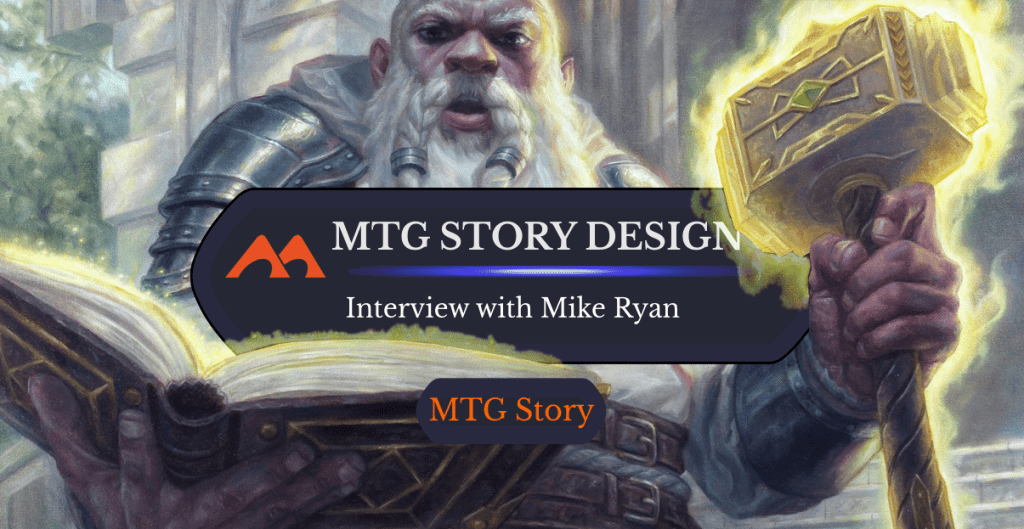
Priest of Ancient Lore | Illustration by Jarel Threat
There are many faces to Magic: The Gathering. Mark Rosewater has been on the front lines in the public sphere as Magic’s head game designer since 2003. The artists of Magic, like Mark Poole or Rebecca Guay, are constantly at events signing cards and talking to players.
Some of you might even think of professional players or content creators like Luis-Scott Vargas (LSV) or Brian Kibler first. But there’s one person who’s left an unmistakable mark on the game when it comes to the lore and creative process, and that’s the former senior editor and first story manager of MTG, Mike Ryan.
I was recently lucky enough to talk to Mike Ryan about how he got started at Wizards of the Coast, what his roles were, how Magic’s story came to be, and the trials and tribulations he and MaRo faced way back in 1997. And today I’ve got all the juicy details of those conversations for you. Let’s get started!
Story Origins: Who Is Mike Ryan?
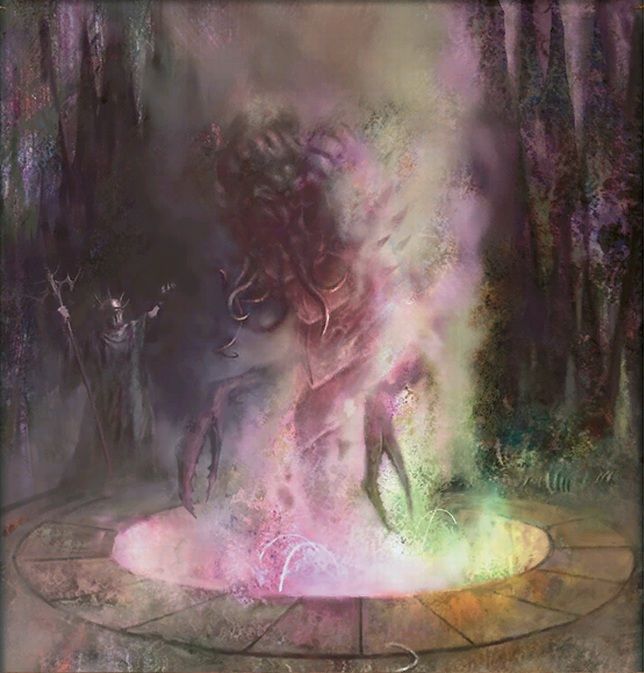
Introductions Are in Order | Illustration by Nils Hamm
Mike Ryan is one of the fathers of Magic’s story. He wrote the original Weatherlight storyline with Mark Rosewater in 1997, which is considered to be the “start” of the game’s lore. He started off as an editor but quickly rose through the ranks into the writer’s room and had a major impact on the character arcs in the story, and MTG’s creative process in general.
First, what were your primary roles during your time as both Senior Editor and Story Manager at WotC?
When I first came aboard at Wizards, I was a Magic editor under Darla Willis, who was the lead Magic editor. At that time, Fourth Edition was soon to be out, and my first editing job was to edit the Player’s Handbook that would be released with it. In time, I’d become more involved in other aspects of Magic—Duelist articles, card naming, flavor text, and finally story.
Story came about because both Mark Rosewater and I have backgrounds in writing, and we set about brainstorming a backstory to the setting where we perceived it had struggled in the past. There were elements of story all over Magic’s history, Urza being a prime example from very early on, but nothing cohesive held it all together back in 1996–1997.
So, he and I charted out a board of the core characters that would be both archetypal and representative of the Magic “color wheel.”
From my research, you were a technical editor before Wizards and Mark Rosewater wrote television and made puzzles for The Duelist. Did you have any creative writing experience that helped you when writing the story with Rosewater? Or did you two just know the fundamentals of what made a good story and decided to take a leap of faith when presenting your ideas?
Yes, I had been an editor for the National Council of Teachers of English, and Mark had written television scripts for television shows, most notably Roseanne, which displayed his writing credit as the only script writer for that episode in the credits. But we’d also both done creative writing on our own—Mark had some truly wonderful sci-fi scripts in mind that I plan to steal if he dies before me without publishing them, and I’d published short stories, my first in Dragon Magazine. We also both took a writing class together at that time at the University of Washington under an excellent instructor who still teaches there, Scott Driscoll.
We both knew the fundamentals well enough to begin outlining, and our class helped us focus, as did input from others like Pete Venters, the aforementioned Bill Rose, and editor Jennifer Clarke Wilkes. They were all flavor text writers as well, and they had good ideas that they contributed to the final story by helping define voices. Jennifer was, is, and always shall be, in my mind, the voice of Squee the goblin. In fact, her email address includes his name, I do believe.
Since you were a Magic player before starting at WotC, did you have any exciting aspirations for storylines or card design when you first got hired? Did any of these come to fruition?
In truth, I didn’t—I had been an editor for the National Council of Teachers of English up to then, and so my concepts about how much leeway an editor has were constrained by working with college professors as authors, who were not interested in one’s personal suggestions for how to expand their writings. In many businesses, there’s a “stay in your lane” mentality, and I was prepared for that at WotC.
Once it became clear that my input was welcome, then the suggestions started flowing. But in the beginning, I was still taken aback to have Richard Garfield say “hi” to me in the corridors.
Workflow At Wizards
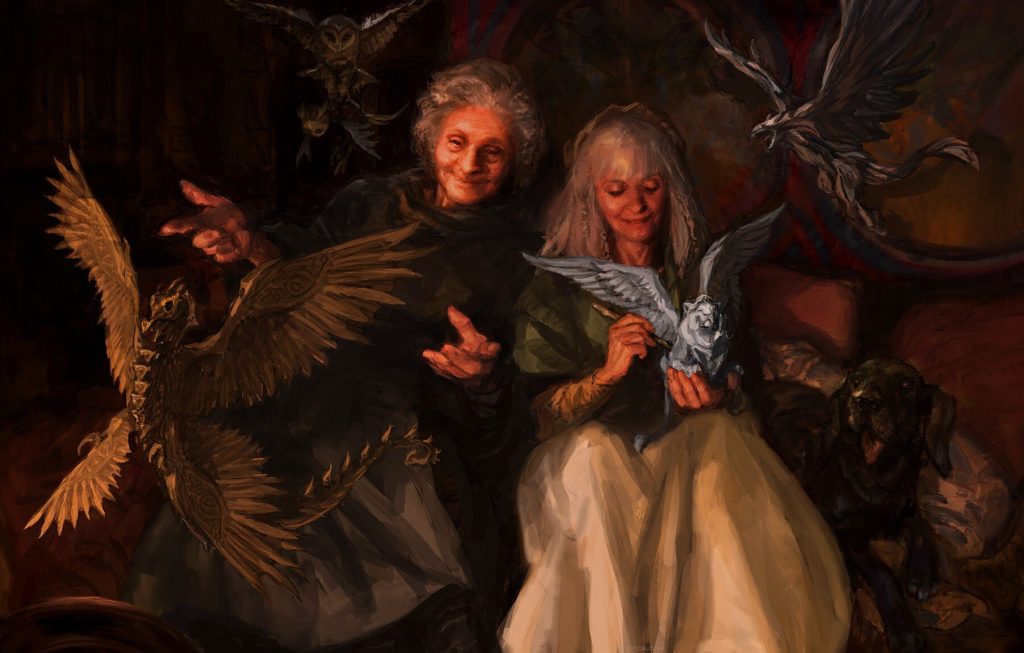
Workshop Elders | Illustration by Iain McCaig
It can be exciting to think about the process of designing your own card. The mana cost, the value, the color—it’s a lot to think about. But players usually overlook the creative process behind each card when they daydream and speculate about how Magic cards are made. Each card has to have dedicated art that represents a scene from the story, the flavor text need to be insightful but often also funny, and the sets as a whole have to follow specific arcs in the lore.
Cards aren’t even the entire job, either. A fully fleshed-out story with narrative and direction needs to be made before any names of cards or art can come to be. It can be a lot to handle, maybe even too much at times, which is why one of the first things I asked Mike about was the design of the Rath cycle’s intricate storylines.
How was the lore and the various storylines managed on the backend during the later sets of the Rath cycle? Were the stories planned out in advance, or was a single set’s full story fleshed out entirely and then you moved onto the next one while those sets were being released?
The way Mark and I originally envisioned it, the Rath cycle was just the first of three cycles, three expansions per cycle, with nine total expansions telling the story of the Weatherlight. We had specific arcs for all the core characters and specific major plot points established for each of the nine parts. In essence, if you use the classic three-act structure, a single expansion would have three acts in it, which combined would form the first act in a three-expansion release (one full cycle), and then that cycle would serve as the first act in a 3-cycle, 3-act structure to tell the entire story. It was simplistic yet complicated, and we were very proud of it. (In light of Star Wars films having gone to nine total films with no discernible planning between cycles of three, I think Mark and I were MCU-level of plotting!)
Now, that said, it came off the rails about as fast as it could. We had a couple of “leaders” in the story development who were either a) financially obsessed or b) artistically obsessed, and neither of them knew squat about story. They were on us regularly about elements they wanted to see in the story—they’d see a picture of some prehistoric beast and decide it had to be a central element in the next expansion, so we were fielding demands for inclusions on a regular basis. These inclusions weren’t built into the story in any way—they were ideas that people with more authority than us had some personal desire to see manifest in the cards, and so Mark and I spent about half our time NOT writing story; instead, we spent that half trying to explain to these non-writers why their writing wasn’t good. But it was like trying to explain the motives of a mammal to a plant. We mashed a bunch of stuff in, but we kept running up against the complaint of one boss in particular who liked the word “derivative.” He’d say, “Volrath is derivative of Darth Vader.” Um, yes, and no! It’s an archetype! I felt like I was bleeding from the eyes because of the constant berating by levels of arrogant stupidity we were dealing with.

Volrath the Shapestealer | Illustration by Heonhwa Choe
Thus, as Mark and I began work on what would become Stronghold, the battle lines were drawn, and we had very little hope of winning. What started off with a bang in Tempest had the rug yanked from underneath it before Stronghold was done. And Exodus was snippets of our story culled and edited and replaced by the yes-men who followed us and tried their best to steal what we’d created but without the vision.
In the 23rd issue of The Duelist both you and Mark Rosewater describe the creation of the fleshed-out version of the plot for the Weatherlight Saga, which started with just an outline between the two of you and ended with the whole creative team being “locked in a room for a few days to brainstorm.” How accurate of a portrayal was this of the worldbuilding and story-writing process? Was this a consistent method across the sets and stories you worked on, or was this just how it went the first time around?
This is mostly accurate; what it leaves out is that we didn’t function well that way. At one point, Mark and I were referred to as “prima donnas” because we knew what we wanted and we knew it was right. It’s the kind of insult that just underscores who knows what’s going on with a given project and who feels cut out. (For the record, he was “prima” and I was “donna.”)
We didn’t really care—we were fighting hard to protect the integrity of a well-thought-out story in the face of opposition from those who wanted “a” story but not “our” story once they put it in motion. The way I came to view it later was they wanted monkeys that could write Shakespeare, not monkeys that could write in general.
Whatever story they’d not yet thought of that they wanted, what Mark and I proposed ultimately wasn’t it… though we didn’t learn that until we were well underway. So, the group meetings for brainstorming went well when we worked with managers, other writers, editors, and artists who bought into the story and were looking to improve it; they were disastrous when we met with those who came in with a separate agenda and goal that didn’t include the story.
In the same issue, a sort of feedback loop was described between those who did story management and the creative art team. It was described that one side would present their work so far and the other would build upon it and send it back. Mark Rosewater even described there “always being a nice give and take.” This makes it seem like there was a wonderful dynamic between the two teams. But Rosewater describes a sort of “schism” that developed once he and you were both removed from being the ones in charge of the story. Was this schism the result of the creative team’s dislike for new management, or something else?
That schism actually began with Mark and me resisting the direction from select artists on the “team” and their leader, who was ultimately our manager, he who preached “derivative.” We explained endlessly why what we were doing would work, only to be told, “We artists have an idea for these lava tube-like things. Work them in.”
Yet when we proposed for the Stronghold expansion a method by which you could dissect all the individual pieces of art on all of the cards in the expansion and, using them in comparison to one another, visual a map of the stronghold—with one room clearly missing from the map you ultimately created. In identifying the missing room, you’d earn a special card we’d mail you, we were told, “That’s too complicated for the artists.”
And at one particularly frustrating meeting, Mark asked the derivative manager, who was an artist himself, “If I asked you to explain the color wheel, could you?” “Of course,” the manager answered. “Okay. How about the three-act structure?” “Um, no.” To which Mark reacted loudly, “That’s because you’re an artist, not a writer!” But in the end, it gained us little.
The Design Team vs. Creative: Who Depends on Who?
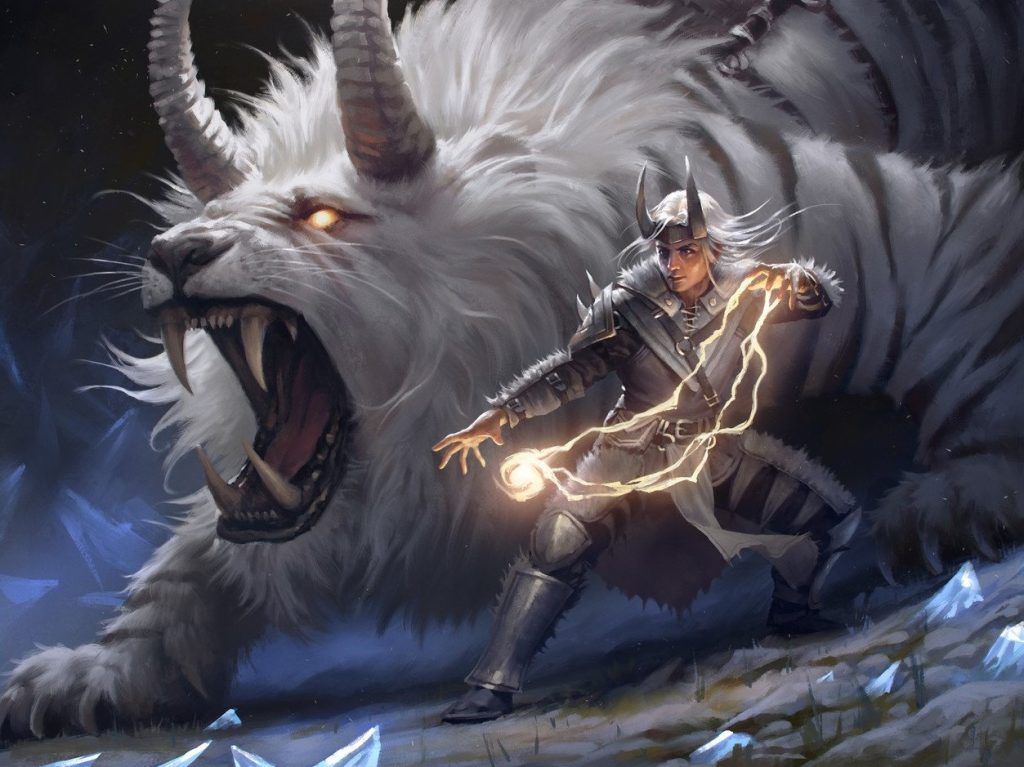
Fight as One | Illustration by Bryan Sola
It's no secret that Magic cards are snapshots from the story. Cards as recent as Neon Dynasty show pivotal plot moments, like Tamiyo's Compleation, while others like Dockside Chef and Boseiju, Who Endures do the worldbuilding.
But something I’ve always wondered is how these cards are made in conjunction with the story writing. Did design rely on the creative team’s ongoing story writing, or were these scenes just tacked onto pre-existing designs? There was no better person to ask than Mike!
Obviously, the cards of Magic: The Gathering play an important part in visualizing and giving visual depth to the characters from the storyline. How much did the design of these cards rely on the story itself? Were these cards designed from a mechanical standpoint and then given a name, art, and theme based on the story, or the opposite?
If you go back and look at Tempest, you’ll see where we were in full bloom—a huge number of cards were specifically given art direction to plug into the story as the Weatherlight crew arrives in Rath. All the major characters appear on the cards, and all the plot points are covered. Magic mechanics themselves, however, were determined by the R&D team well in advance of any story—we’d just begun trying to include story, so the synchronicity between the writers and the developers wasn’t very tight yet, something I believe has improved immensely over the years.
So, we would review the mechanics on the cards and see where story could fit in. Because Mark was part of the writing team, he had some ability to go back to the developers and suggest we change, tweak, or even eliminate/add something to fit a story point. But card names and art came well after the fact of card mechanics, so a card could begin life as a 5/5 Swamp Monster with flying, and we’d have to take it from there for the story.
The best example I have of this was working in the Slivers and the Sliver Queen, as the whole hive mind idea of that mechanic already existed when we approached that expansion with story elements.
During your time on the creative team, did you or any of the other writers have any impact on the flavor text of the cards, or was this all done by a single person?
All of us were flavor text writers, some of us even taking select characters and writing their voices on every card that character was quoted on. As a team, we’d meet and vote on the flavor text options for any given card, and this was how things were being done before we got to the Weatherlight crew.
I have flavor text entries of my own on cards in Mirage and Visions, and one of my favorites from that time by Mark Rosewater was on the Mirage card Dwarven Miner: “Fetch the pestridder, Paka—we’ve got dwarves in the rutabagas!” from some farmer. We were working together in the dead of night at the office, and Mark suggested it for this card. We both got the terrible giggles and decided, “Well, this must be it! This is the flavor text!” So, I took it to Darla, who had the final say on the cards, and she said, “The dwarves would have to be under the rutabagas.” So I tweaked the text to “underneath,” and Mark lost his mind. “Comic timing!” he screamed. “It has to be one syllable or you break the comic rhythm!” So, I changed it to “‘neath,” which almost gave Mark a seizure. “That’s not even a word!”
Well, at this point, I was getting pissy and felt trapped between what Mark wanted and what Darla dictated. I shouted at him, “How about if it says nothing on the card, then? How’s that sound? I’m done with this argument!” This calmed him a little, but if you’ve ever argued with Mark, you realize he’s not going to argue a different angle when he lowers his voice—he’s still going to endlessly repeat the exact same reasoning, just in a more reasonable tone. This was enough for me to go back to Darla and say I felt I was between a rock and a hard place, only to have her shrug and say, “I don’t really care either way.” Sigh.
Looking Back
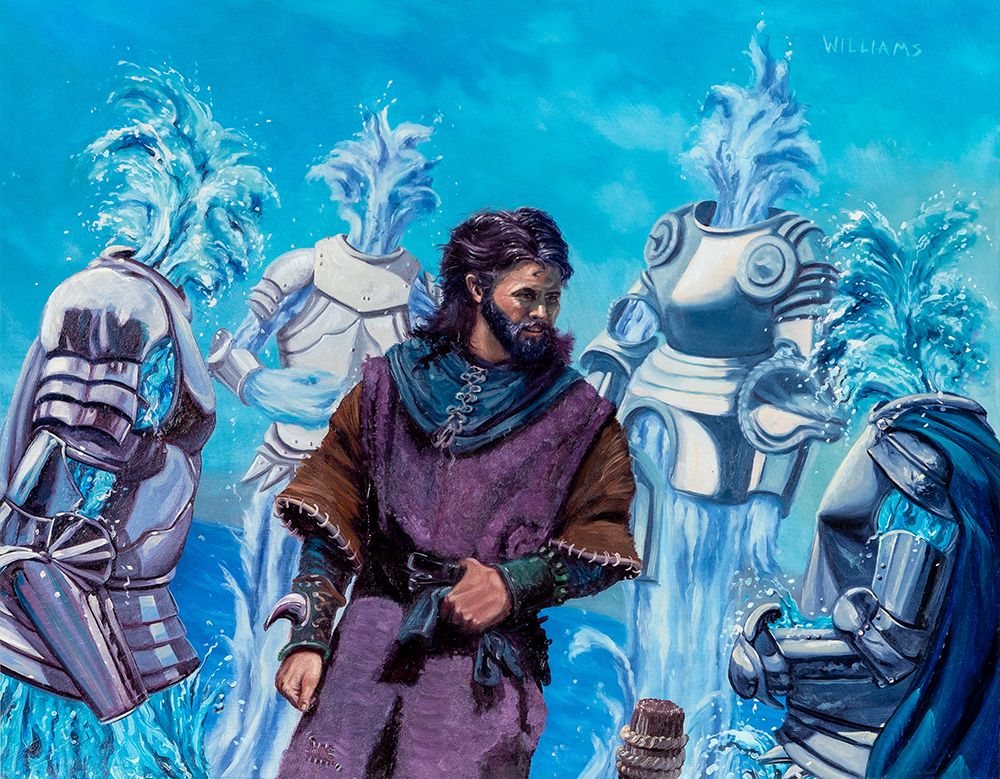
Reminisce | Illustration by Bradley Williams
Mike Ryan left Wizards of the Coast in early 2000, which was shortly after Magic’s magazine The Duelist stopped print publication. I was able to read a few of these magazines early on in my Magic career and I was absolutely hooked. Each issue was filled with behind-the-scenes articles by game designers, interesting deck designs that rocked my world, and at one point even featured some rejected designs for Magic cards.
I was dying to know if they ever had plans to release more of these, and if Mike had any guesses as to what would happen.
Did your absence at WotC have anything to do with the end of The Duelist and its transition TopDeck, or were these two events just coincidental? Do you think a return of a similarly designed monthly magazine would have as much success if it was done today?
Nah, that was a completely different business model and, believe it or not, a separate part of the company. I worked for both The Duelist and TopDeck as a writer and an editor, and I’ve since attempted to launch a magazine for Pokémon (all of one issue) and worked as the editor-in-chief for a magazine devoted to Privateer Press products (No Quarter). Here’s what I’ve learned from all of those: print magazines really, really struggle to make money.
I don’t think a similarly designed magazine would do as well today as those others did in the past, and the reason lies squarely on the internet. You have a fan base with a free platform to publish their content, and the good stuff eventually makes its way to the surface because enough people learn about it and go looking for it. And in the end, that word again is “free.” Even for the direct-from-the-company insight, few players seem willing to shell out the money to keep such a venture afloat, and there’s this pervasive fantasy that digital should cost even less than print because there’s, like, no paper or print costs or distribution involved, right?
The problem is, you have to pay writers, artists, designers, and web personnel to release it. And when readers want it for under two bucks, you have to acquire a lot of readers just to break even. Worse, if you don’t generate DNC programs to protect your publication, it just gets posted somewhere, and fans click to read and pay nothing. While the racks are still filled at your local Barnes & Noble, the print magazine struggles harder than ever to find its place in the market, and something as niche as a magazine devoted to a specific game, even one as popular as Magic, has little hope of surviving.
Did you expect that the characters you sculpted for the Weatherlight crew, especially Karn, would be anywhere near as popular as they are today? Was there ever a point in your career that you though, “Wow, these characters are going to be even bigger in 20 years”?
Honestly, I expected different characters to have greater longevity. I thought Crovax, being a vampire, would be a fan-favorite and would be popular indefinitely. Gerrard was Captain Kirk—and apparently generated love/hate reactions much like Shatner did. From the word go, I envisioned a film, or at least an animated series, that would boost the player enthusiasm for each of the characters and that they would find their hardcore supporters—but they got killed off in relatively short order and, in some cases, for minimal dramatic effect.
It was disappointing because I thought you could split them off, toss them into new scenarios with new characters, and have an entirely different structure for the next world in a multiverse. I’m glad that both Karn and Squee have found lives in the aftermath of the decimation of that original storyline, and who knows? Retcon still happens. I have a thousand dollars’ worth of Star Wars novels that are now called “Legends” since Disney no longer supports the stories, and there are old Marvel Comics and Dark Horse Comics that also supposedly don’t count. Maybe the time will come when only the Rath cycle will count… or maybe even just the initial Rath story in Tempest, and I’ll get a chance to write a novel about them after all.
If you could, would there be anything you’d have done different when you worked for WotC? Were there any decisions about characters or how certain character arcs ended that could’ve been better in hindsight? If so, did this impact how you and or your team going forward?
I wasn’t involved, or even at the company anymore, to see all the arcs through to the end. But there are things I might have considered altering earlier on to punch up a couple of characters because I felt like we added them just to round out the team.
Ertai could have been given a greater role with a goal of becoming a very powerful wizard who might have been full of himself to the point of being a passive enemy. Hannah was to be Gerrard’s love interest, but given the genre and the audience, we were reluctant to move that forward much, but in the intervening years I’ve learned a great deal more about how to write romance without boring an audience that isn’t looking for a Hallmark or Harlequin romance moment.
What would your advice to the current story team be? Have you learned anything since leaving that would’ve been quite helpful during your time at Wizards?
To be honest, I’ve not kept up with the Magic stories in the two decades since I left the company. Mark catches me up from time to time, but I am reluctant to be too interested—I don’t want to have a vested interest in something I helped start but which I’ll likely never be asked to participate in again. So, for all I know, they have a solid foundation and are building a story the current Magic audience wants to see. If that’s the case, then more power to them! We live in a time of such short attention span that if they keep an audience invested in what happens next, they deserve the kudos that goes with that (and a salary commiserate with their success!).
The things I’ve learned since leaving that might have served me better back then are sometimes writing rules and insights, especially as you watch how literature itself is evolving and our interest in new archetypes expands. While I don’t know if we’d have been bold enough to have a gay or maybe even transgender character back then, that turmoil that comes from not being accepted by your society and feeling like you can’t be yourself is a universal feeling that, now, is finding far better means of expression than existed when we were developing story. It would be a strong element now, provided the writers didn’t make it feel token or deliberately PC.
But the one thing I’ve learned in the last twenty years that I wish I’d had then is less ego, more patience with the opinions of others. I am much older now and recognize that people don’t always dismiss your creativity because they don’t like what you’ve done—they just want to be heard for what they might want to create. Knowing that, it’s easier to listen to someone’s feedback and not let your ego get in the way of actually hearing them and giving them a chance to participate. It’s a nice, big sandbox; we can all play in it if we can just not kick the sand at the others around us.
That said: “derivative.” Nope. My ego still refuses to hear that nonsense.
What would be your advice to young writers and editors alike who want to get started in the game industry? Is focusing on gaming and making your own stories and adventures a good start, or is it better to get professional experience anywhere you can and then try to use that experience to get roles elsewhere?
Get that experience anywhere you possibly can. I’ve seen over the years how newcomers to the field want to step in with an entirely new intellectual property, and that’s a shockingly slow burn—it requires a lot of investment from any company backing it, and in the end they’re going to want to change things that you hold sacred if they do decide to go forward with it, and you’ll be at a loss for how to proceed.
So, if you want to design an RPG adventure, can you get involved in D&D? Don’t world build—that’s for when you have the money to lay out for your own Kickstarter. Too many designers become obsessed with how coins work in their new realm or want to invent whole languages, and then stories and characters get VERY short shrift. In the end, players marvel at the details of a new world… but only if they have an avenue to see it, and that’s through characters and plot.
Now, that’s the writer’s advice. For the editor, many game companies don’t want to expense of keeping an editor or two (or more) on payroll, so they contract out all the time for freelancers. Get on a list. Write to an in-house editing coordinator and lowball a contract so you can show what you can do. It goes without saying, do a good job, but I’ll say it anyway.
There’s this three-point checklist that I use when hiring a freelancer, and it goes like this:
1. Are they easy to work with? Pleasant, responsive, open to feedback, easy to get a hold of?
2. Are they deadline-driven? Does the work show up on time, if not early? Is it formatted just as we agreed to and with queries easy for me to find and sort out?
3. Are they accurate? Is their overall editing flawless and requires no in-depth review on my part to ensure it’s right? Could I even reach a point where I trust the editor enough to just send it along to layout with only the minimal back-edit on my part?
If you have any two of these three qualities, you’ll get and keep getting work. Someone in-house will compensate for whichever one you’re missing, and they’ll come to you over and over if you can hit all three. But miss two of these? You can just delete their email from your system.
A New Digitally Prominent World
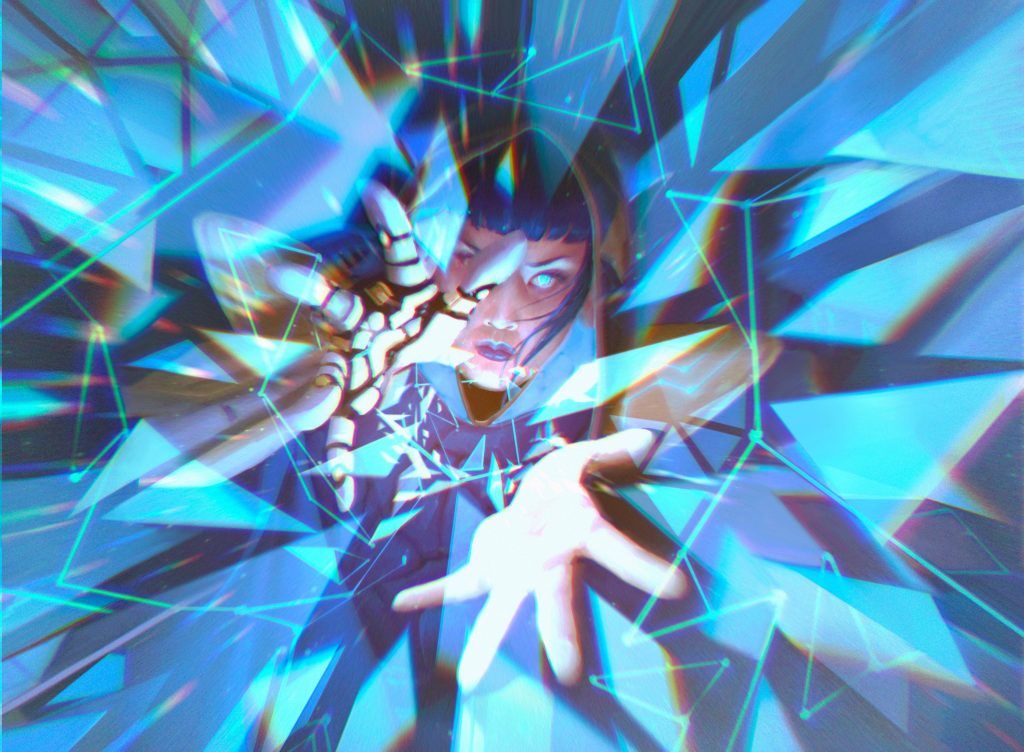
Disruption Protocol | Illustration by Pauline Voss
Of course, it wouldn’t be an article about Magic in 2022 without mentioning MTG Arena. Magic has changed a lot since Mike was working on the storyboard, and a big part of that has been the transition to digital platforms.
Obviously it isn’t just the game that’s online now. Magic’s story, interviews, developer articles, and news has been moved to digital platforms since Mike’s departure. Mike had an interesting take on this one, and it brought up something most people don’t seem to take into account: having all your collection in a single place.
How does the more “digitally prominent” approach that Wizards is adopting now, like the new MTG Arena game client, change the narrative design process? Do you think having new digital-only cards and formats has an impact on the creative side of Magic?
I come at this from the perspective of a collector, which is one of wanting to have it, hold it, look at it, tuck it away, take it out, and look at it again. If you read a series of books and books one through three are in hardback but book four is in paperback before you go back to hardbacks for books five and six, some pedanticism kicks in that wants book four in hardback. Maybe that doesn’t bother you as much. But if book four was digital-only while the others were print, you might feel more aggravated.
And then there’s this: the MCU is now spread across 20+ movies, all of which you can buy on DVD/Blu-Ray. But you must have Disney+ if you want Loki, WandaVision, The Falcon and the Winter Soldier, What If…?, and the others. Same thing with Star Wars; no sign of The Mandalorian on DVD anytime soon. Your collection gets mixed up in the media, and it presents a sore spot for storytelling.
If you make a reference to a plot element that’s on a platform your audience might not have, you gotta make that reference standalone yet development at the same time. You have to reward the audience who’s in the know of what’s gone on elsewhere while not disappointing those who are more casually involved. The moment someone has to say, “I don’t get it,” you’re losing them. It’s a high-wire act that can be done well if your audience is hardcore committed. I don’t know that Magic players are as committed to the story as they are to the game itself.
Since leaving Magic, you’ve taken on a long career as the managing editor for Pokémon USA. How does your work there differ from your primary role when you were working on Magic? Is there anything you miss doing in that time that you don’t get to do much of now?
Actually, I was the director of editing for Pokémon for eight years (until 2012), and after that, I served as the editor-in-chief for No Quarter magazine from Privateer Press for a number of years and now serve as a director at Privateer, where we make the games WARMACHINE/HORDES, Monsterpocalypse, Warcaster, Riot Quest, and the Iron Kingdoms Roleplaying Game for 5e. While at Pokémon, I was given a much greater opportunity to hone some leadership skills, but I missed the creative writing—much of the Pokémon world is created and refined in Japan, so we did more translation than original content. (That said, when we had the chance to name Pokémon, I named the evolved Pokémon “Braviary.” My primary claim to fame working there!)
At Privateer, I’ve been able to apply those management skills I learned at Pokémon while coupling it with a healthy amount of creative writing for the magazine, sell text, blog-like posts, and RPG work. Because I’m not intimately involved in the rules development, it’s a lot like being a Magic editor again—I edit and template what the R&D team gives me. And while I don’t work with anyone as intimately as I did with Mark (pandemic notwithstanding!) I do have a creative bond with the company owner, Matt Wilson (who worked on Magic back in the day, too!), and the head of the RPG line, Matt Goetz. I feel like I’ve grown in ways that might have benefited Magic had I stayed—after all, Mark Rosewater has now been there for twenty-five years. He’s risen to the top when it comes to outlets for his creative concepts with an audience eager to hear them—even if only so they can criticize him for them.
I am sometimes reminded that Mark is something of a celebrity in his world and that I used to be a part of that world. Magic players are fiercely opinionated yet steadfastly loyal, and I miss that sometimes. At Pokémon, the audience was mostly children for a long while, and it took a long time for that generation to grow up and embrace their pasts to appreciate the games again. At Privateer, our audience is equally devoted but smaller than that of Magic, and I always hope we’ll get more players who like what I bring to the table for the company.
The one thing I miss the most, I must confess, is the camaraderie I experienced in those early days of Magic. Everyone was young, everything was new, and everyone befriended everyone at the company because everything we did was exciting, even our bombs. I felt like I had three dozen friends there by the time I left after five years, and I’ve not experienced that in any workplace before or since. I don’t regret leaving when I did—if you’re happy in your life, then all the things you did before were the right things to do to get you where you are now—but sometimes I wonder: What if I had a Time Walk?
Wrap Up
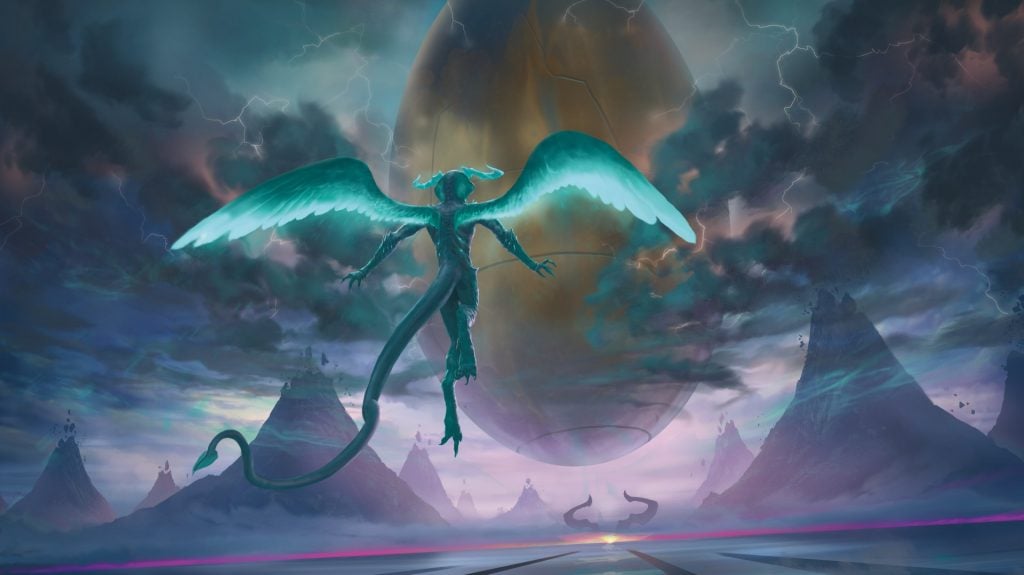
Finale of Revelation | Illustration by Johann Bodin
Thanks again to Mike Ryan for coordinating this interview with me and being such a pleasure to work with back and forth the last few months. It was great walking down memory lane and learning about how Wizards worked back in the good ol’ days.
Make sure to check out some of our other articles, follow us on Twitter, and check out the official Draftsim Discord for more content like this.
Until next time, stay safe and stay healthy!
Follow Draftsim for awesome articles and set updates: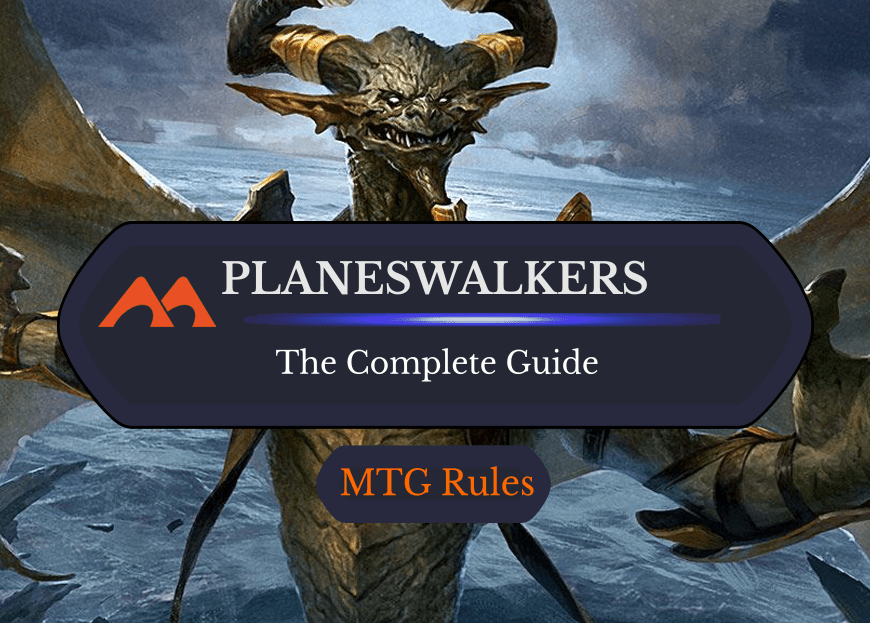
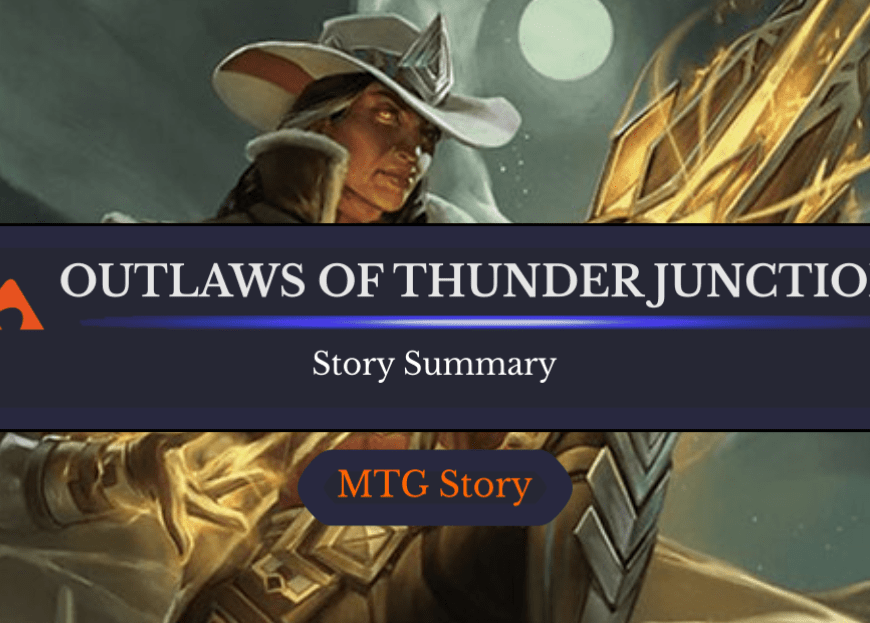
Add Comment